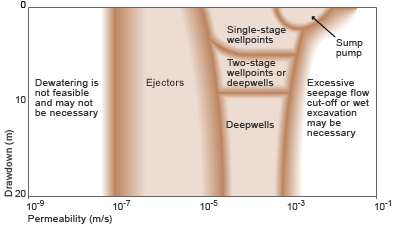What is Dewatering?
Dewatering systems are routinely used in the construction industry to provide temporary reductions in ground water levels for structures which extend to below groundwater level. A dewatering system generally comprises an array of wells or sumps which are continuously pumped so as to lower the water table to provide stable and dry conditions to facilitate excavation. Dewatering systems may be used around open cut excavations or in conjunction with shoring or retaining walls used to support the excavation. Where retaining walls are used the dewatering well array may be installed internally to exploit the cut-off effect of the shoring arrangements.

Range of application of dewatering techniques (based on CIRIA C515, London 2000)
Alternatively an external well array may be deployed to reduce the hydrostatic loading on the shoring system or allow use of lower cost shoring arrangements such as contiguous piles as opposed to secant piles.
Once the structure is completed or sufficiently complete to resist hydrostatic loads that the pumping can be stopped and groundwater levels allowed to recovery back to their natural levels. Very occasionally it can prove cost effective to provide long term or permanent groundwater control to avoid uplift pressures.
Groundwater control extends this definition to encompass any pumping or recharge system used to manipulate groundwater levels for a range of purposes. Examples include; recharge systems used to limit external drawdown and mitigate settlement risks; vacuum drainage systems for pore pressure control in fine soils; hydraulic barriers used to control migration of contaminates; groundwater lowering used to under-drain and consolidate weak soils; and groundwater lowering to facilitate pile construction.
The choice of pumping system used for dewatering or groundwater systems depends on the amount of drawdown required and the ground conditions; see diagram. The assessment of the ground conditions is generally based on a geotechnical borehole site investigation sometimes supported by specialist pumping tests.
Kampco Pumps & Dewatering uses geotechnical instrumentation and monitoring to monitor water levels and system performance. Monitoring drawdown and discharge flow rates are important to validate a dewatering scheme.
In fine soils such as silt and silty sand, dewatering is primarily concerned with reduction in pore pressures rather than reduction in the water content. This is because capillary action allows significant reduction in pore pressures with minimal change in soil water content.
Kampco Pumps & Dewatering is a dewatering contractor that designs, installs and operates deepwell, ejector or wellpoint dewatering systems. To learn more about the types of dewatering systems available, please click on the highlighted text above or links to the left of the page. Alternatively, contact us today on +966 13 8944 111.





